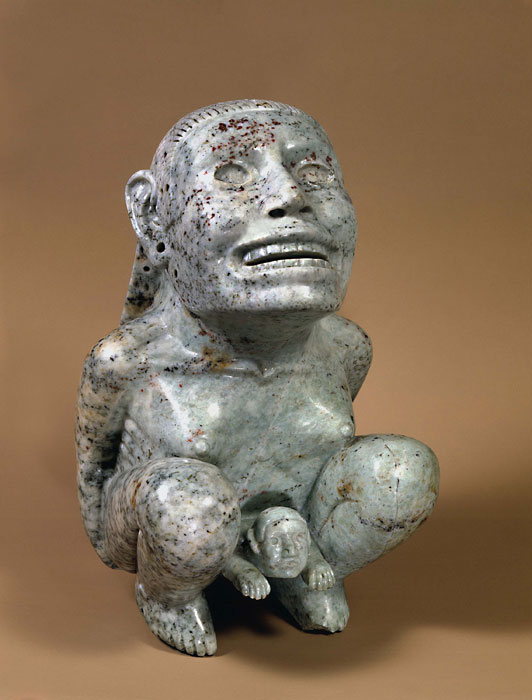Situated on an altar at the center of the inner sanctum of the cave-like temple, a golden idol is the privileged object in the opening sequence of Raiders of the Lost Ark. Obtaining it has been the entire goal of the archaeologist-adventurer Indiana Jones, while protecting it from potential pillagers was evidently the primary concern of those who constructed the elaborately booby-trapped building that houses it. Her grimacing countenance seems to suggest a fearsome snarl,especially as we have just witnessed the litany of trials a supplicant would have to pass through before encountering this figure. Upon closer inspection, however, it is revealed to convey the pain of parturition, as a small infant can be seen emerging from her squatting and naked body.
This cinematic fertility goddess was directly copied from a well-known Aztec-style statue in the Dumbarton Oaks Museum collection. There has been a shift in materials from stone to gold, presumably as a outward indication of the statue’s value, justifying to the audience the potentially deadly ordeals that the adventurer-protagonist has undergone to obtain it and setting it apart from the numerous other carved stone images that have remained peripheral during this journey. Additionally, the head has been enlarged and the grimace made more pronounced, undoubtedly to heighten the statue’s ferocity when seen from a distance, as discussed above. Nevertheless, the copy has stuck close to its prototype, which was likely chosen by the filmmakers based on its combined animalistic fierceness and overt sexuality as a suitable object to represent—indeed to epitomize—the primitive Other.
While exaggerated in the movie version, these same characteristics were probably calculated to appeal to late 19th and early 20th century collectors, for—perhaps ironically, perhaps inevitably—the filmmakers chose a modern fake as the model for their paradigmatic idol. Not only does the Dumbarton Oaks statue present numerous features that are not found in other Aztec sculptures, but microscopic analysis of its surface has definitively shown that it was carved with precision tools unavailable to ancient artisans.¹ We are therefore confronted by a simulacrum (in the Baudrillardian sense of a copy lacking a prototype) that presents a thoroughly Western idea of the non-Western Other.
To add a layer of absurdity to the situation, the idol from Raiders of the Lost Ark has itself gained iconic status as a cultural artifact due to its key role in an extremely popular, genre-defining movie. This has led to multiple fakes of the film prop being sold at auction in recent years, often for five-figure sums.
¹Jane MacLaren Walsh, “The Dumbarton Oaks Tlazolteotl: Looking beneath the Surface,” Journal de la Scoiété des Américanistes 94.1 (2008): 7-43.

